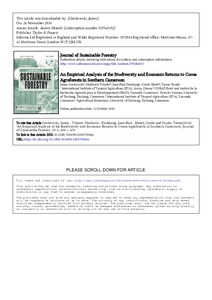| dc.contributor.author | Gockowski, J. |
| dc.contributor.author | Tchatat, M. |
| dc.contributor.author | Dondjang, J.P. |
| dc.contributor.author | Hietet, G. |
| dc.contributor.author | Fouda, T. |
| dc.date.accessioned | 2019-12-04T11:13:58Z |
| dc.date.available | 2019-12-04T11:13:58Z |
| dc.date.issued | 2010 |
| dc.identifier.citation | Gockowski, J., Tchatat, M., Dondjang, J.P., Hietet, G. & Fouda, T. (2010). An empirical analysis of the biodiversity and economic returns to cocoa agroforests in Southern Cameroon. Journal of Sustainable Forestry, 29(6-8), 638-670. |
| dc.identifier.issn | 1054-9811 |
| dc.identifier.uri | https://hdl.handle.net/20.500.12478/2586 |
| dc.description.abstract | Arguing that agroforestry associations are important for biodiversity conservation, certification schemes are seeking to differentiate commodities on the basis of the biodiversity included in the cropping system, in order to financially encourage more“wildlife friendly” production systems through market mechanisms. However, biologists and economists have begun to question the overall impact on biodiversity and poverty when relatively extensive “wildlife friendly” agroforestry systems are encouraged in lieu of more intensified systems. Field inventories were taken of the plants utilized from 67 ha of cocoa agroforests (CAFs) in southern Cameroon among 46 households. Two hundred eighty-six plant species were utilized as foods, medicinal plants, timber, and service products. From interviews with household members it was revealed that non-cocoa revenues accounted for one quarter of total CAF revenues. Per capita revenues from the CAF were positively skewed and exceeded the poverty line for 29% of the sampled population. Monetary returns from the CAF increased with increasing agricultural intensification and market access. The findings suggest that intensified use of cocoa fungicides, improved market institutions, and expansion of the CAF area cultivated per household would reduce rural poverty in southern Cameroon. Overall, the plant diversity of CAFs degraded slightly as intensification proceeded. |
| dc.description.sponsorship | World Cocoa Foundation |
| dc.description.sponsorship | United States Agency for International Development |
| dc.format.extent | 638-670 |
| dc.language.iso | en |
| dc.subject | Southern Cameroon |
| dc.subject | Agricultural Intensification |
| dc.subject | Biodiversity |
| dc.subject | Cocoa Agroforests |
| dc.subject | Poverty Reduction |
| dc.subject | Trade-Offs |
| dc.title | An empirical analysis of the biodiversity and economic returns to cocoa agroforests in southern Cameroon |
| dc.type | Journal Article |
| dc.description.version | Peer Review |
| cg.contributor.affiliation | International Institute of Tropical Agriculture |
| cg.contributor.affiliation | Conference des Responsables de Recherche Agronomique Africains-Foret and Institut de la Recherche Agricole pour le Développement, Yaoundé |
| cg.contributor.affiliation | Université de Dschang |
| cg.coverage.region | Africa |
| cg.coverage.region | West And Central Africa |
| cg.coverage.country | Cameroon |
| cg.coverage.country | Nigeria |
| cg.coverage.country | Cote D'Ivoire |
| cg.coverage.country | Ghana |
| cg.isijournal | ISI Journal |
| cg.authorship.types | CGIAR and developing country institute |
| cg.iitasubject | Markets |
| cg.iitasubject | Plant Production |
| cg.iitasubject | Agribusiness |
| cg.iitasubject | Biodiversity |
| cg.iitasubject | Cocoa |
| cg.iitasubject | Forestry |
| cg.journal | Journal of Sustainable Forestry |
| cg.howpublished | Formally Published |
| cg.accessibilitystatus | Limited Access |
| local.dspaceid | 93390 |
| cg.targetaudience | Scientists |
| cg.identifier.doi | http://dx.doi.org/10.1080/10549811003739486 |

